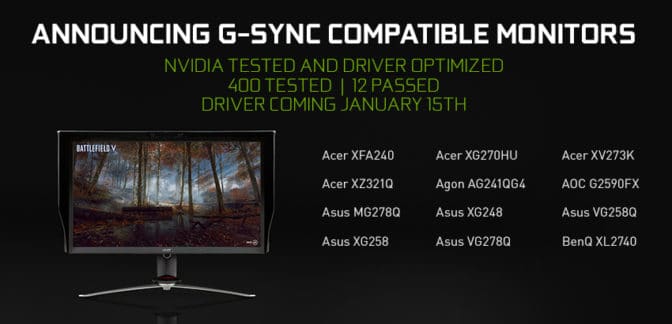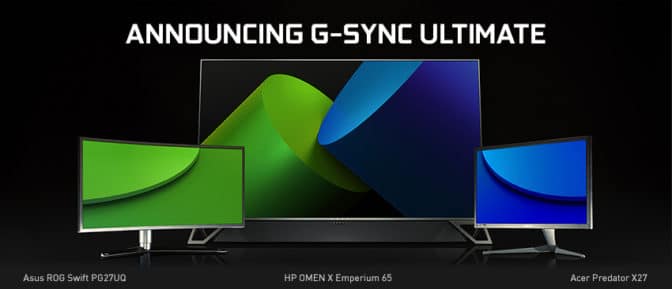We’re displaying for keeps at CES this week in Las Vegas with the expansion of the G-SYNC ecosystem, pre-orders of our new BFGD monitors and the announcement of new G-SYNC displays.
These announcements build on our ongoing investment in G-SYNC display technology, which has delivered superior gaming experiences since 2013.
The revolutionary monitor technology introduced gamers to smooth variable refresh rate gameplay, with no screen tearing and no V-Sync input lag.
We then brought G-SYNC to laptops in 2015 and, last year, we announced we’re bringing it to living rooms and dens with the BFGD displays.
And we broke new ground with G-SYNC HDR monitors that are the very best displays for HDR gaming on PC. They offer the best tech, the highest brightness, cinematic color and never before seen contrast in gaming monitors to display deep, dark black tones.
Since the launch of G-SYNC, gaming monitors have evolved quickly with higher refresh rates, HDR and new form factors. They’ve become the standard for pro gaming, and we continue to help guide their evolution by working with partners and with end-to-end development and certification testing.
Expanding G-SYNC
Today we’re announcing that we’re expanding the G-SYNC ecosystem.
There are hundreds of monitor models available capable of variable refresh rates (VRR) using the VESA DisplayPort Adaptive-Sync protocol. However, the VRR gaming experience can vary widely.
To improve the experience for gamers, NVIDIA will test monitors. Those that pass our validation tests will be G-SYNC Compatible and enabled by default in the GeForce driver.
G-SYNC Compatible tests will identify monitors that deliver a baseline VRR experience on GeForce RTX 20-series and GeForce GTX 10-series graphics cards, and activate their VRR features automatically.
Support for G-SYNC Compatible monitors will begin Jan. 15 with the launch of our first 2019 Game Ready driver. Already, 12 monitors have been validated as G-SYNC Compatible (from the 400 we have tested so far). We’ll continue to test monitors and update our support list. For gamers who have monitors that we have not yet tested, or that have failed validation, we’ll give you an option to manually enable VRR, too.
For the most demanding gamers, G-SYNC and G-SYNC Ultimate HDR displays featuring an NVIDIA G-SYNC processor will represent the very highest image quality, performance and experience. These displays will benefit from an end-to-end certification process that includes more than 300 tests for image quality.
They’ll feature a full refresh rate range from 1 Hz to the display panel’s maximum rate, plus other advantages like variable overdrive, refresh rate overclocking, ultra-low motion blur display modes and industry-leading HDR with 1,000 nits, full matrix backlight and DCI-P3 color.
Get all the details in the GeForce.com article.
Coming to a Living Room Near You
Our G-SYNC displays are also going big, really big.
In February, G-SYNC HDR tech will be available in 65-inch super-sized NVIDIA Big Format Gaming Displays featuring 4K, 144 Hz with 1,000 nit HDR, 384 zone matrix backlight and cinematic DCI-P3 color.
These displays bring a big-screen gaming experience to PC games and are ideal for a gaming den or even your living room.
If you want the biggest and best G-SYNC Ultimate PC gaming display, it’s available for pre-order now from HP. Other partners will start taking pre-orders as we approach the launch of BFGDs later this quarter.
Stunning New G-SYNC Monitors
Of course, we’re also working with partners to continue pumping out new G-SYNC monitors at a brisk pace.
Soon, ASUS will unleash its curved 35-inch, 3440×1440, 200 Hz G-SYNC Ultimate display. It reaches a brilliantly bright 1,000 nits, has a 512 zone matrix backlight and best-in-class color and contrast for the best possible HDR gaming experience.
LG has just started shipping its 34-inch, 3440×1440, 120 Hz 34GK950G display, which is the first G-SYNC monitor to feature LG’s Nano IPS technology, delivering stunning color fidelity.
Acer is showing off its 27-inch, 4K, 144 Hz monitor, which is ready to amp up hi-res, high frame rate gameplay with the latest Turing GPUs.
And Lenovo unveiled its 27-inch, 2560×1440, 240 Hz monitor, bringing esports-class refresh rates to QHD resolution for crisp, detailed visuals during gameplay.
The result of all this: gamers now have more choices at more prices, and more are coming as we continue to invest in G-SYNC and make gaming better.


